Adaptive Content Frame Skipping for Wyner–Ziv-Based Light Field Image Compression
Abstract
:1. Introduction
1.1. Context and Motivations
1.2. Contributions and Paper Organization
- An advanced WZ-based LF image compression solution: The well-known WZ coding approach is enhanced by improving the compression performance at the key frame encoder–decoder with state-of-the-art video compression using H.265/HEVC [42], while the advantage of the low complexity of the WZ procedure is utilized on the side of the WZ frame encoder–decoder. Additionally, an advanced channel codec (i.e., LDPC codec [43]) is applied in this WZ coding approach to achieve capacity approaching the performance requirements and flexible code designs using density evolution [44];
- An efficient content-driven LF image reordering mechanism: The different scanning methods may affect the results depending on the video content and characteristics. Based on the high correlation of SAIs and different content types of LF images, 4 scanning methods (i.e., spiral scan, hybrid scan, U-shape scan, and raster scan) are evaluated thoroughly in order to select the most efficient scanning methods for LF images, and also to further improve the performance of our WZ coding solution;
- An adaptive skip mode decision algorithm: To further improve the proposed WZ-LF image coding paradigm, an adaptive skip mode decision is introduced using a decision tree rule-based method, which is based on the changes of spatial and temporal features of the LF content sequences. The associated side information is used as the final reconstructed frame when the skip mode is applied to WZ frames.
2. Overall Wyner–Ziv-Based Light Field Image Compression
2.1. Proposed WZ-LF Architecture
2.2. Efficient Sub-Aperture Image Arrangment
3. Adaptive Content Frame Skipping Algorithm
3.1. Observation
3.2. Decision Tree Based Adaptive Frame Skipping
| Algorithm 1 The decision-tree-based adaptive frame skipping |
| Input: 4D-LF pseudo-sequence Output: Skip mode decision (i.e., skip or non-skip) Initialize the data partitioning with WZ frames ( and two consecutive KEY frames (. Extract the attribute feature as following Determine the threshold based on the average value of each features.
|
4. Performance Evaluation
4.1. Test Conditions
4.2. Overall WZ-LF Compression Performance Evaluation
- WZ-LF versus DVC-H.265/HEVC: The proposed codec uses a similar approach to DVC-H.265/HEVC, however with significantly improved coding tools. The proposed WZ-LF achieves impressive results for compression performance compared to DVC-H.265/HEVC by reducing the bit rate by about 25%. Additionally, taking into account the adaptive mode decision for frame skipping, the WZ-LF architecture achieves a significant gain in compression performance of almost 2 dB with different content types.
- WZ-LF versus H.265/HEVC Intra: The advantage of the proposed coding solution is applied to the intra coding solution at the encoder side and to the inter coding solution at the decoder side. Thus, the proposed WZ-LF can significantly improve the RD performance for all 4D-LF pseudo-sequences with a variety of content types. As shown, the average BD rate reductions are 53.14%, 52.53%, 53.22%, and 53.18% for the proposed WZ-LF solution with WDOF, NDOF, NDOF-1, and NDOF-2, respectively. Hence, the obtained performance improvement confirms the efficiency of the proposed skip mode decision in the WZ-LF architecture.
- WZ-LF versus H.265/HEVC Inter: In the case of high correlation between SAIs of the 4D-LF pseudo-sequences, the compression performance of H.265/HEVC Inter is obviously better than the proposed WZ-LF with the asymmetric compression. The H.265/HEVC Inter codec can be considered as the upper bound of DVC-H.265/HEVC outperforming DVC-H.265/HEVC by 10.9 dB in compression performance, however the proposed WZ-LF improves the compression performance by narrowing the gap by about 1.5 dB compared to DVC-H.265/HEVC. Additionally, the major problem with the H.265/HEVC Inter codec is its high complexity, meaning it is not compatible with the emerging applications considered in this work, whereas the proposed WZ-LF is a suitable solution. Regarding the H.265/HEVC Inter codec with no motion, i.e., without motion compensation, the compression performance of this codec is similar to H.265/HEVC Inter because of the high correlation between SAIs, as shown in Table 3. Thus, H.265/HEVC Inter is a suitable comparison.
- Notes on performance variation with content types: Since the proposed WZ-LF solution outperforms the relevant benchmarks, i.e., DVC-H.265/HEVC and H.265/HEVC Intra, the WZ-LF compression performance changes with content type differently to other codecs. By encoding individual frames in H.265/HEVC Intra, the comparison with the WZ-LF solution maintains an approximate 53% bit rate saving for all content types. Notably, in comparison to DVC-H.265/HEVC, the WZ-LF solution achieves the best compression performance for the NDOF content type, with BD rate reductions of 29.3%, while NDOF-1 and NDOF-2 are improved respectively by approximately 20.2% and 23.8%, respectively. The WDOF and BC content types represent the low motion and high correlation between SAIs of the 4D-LF pseudo-sequence. Thus, the bit rate of the proposed coding solution is reduced by 34% and 54% compared to DVC-H.265/HEVC and H.265/HEVC Intra for the BC and WDOF content, respectively. It is noticed that some specific LF sequences with high contrast and saturation contents, i.e., game board, poppies, chain link fence 1, and books, also vary in their bit rate savings and compression performance compared to DVC-H.265/HEVC and H.265/HEVC Intra. For instance, the proposed WZ-LF solution achieves bit rate savings of 48.2% and 53.9% in comparison to DVC-H.265/HEVC and H.265/HEVC Intra, respectively, for the game board sequence.
4.3. WZ-LF Codec with Various Coding Tools
4.3.1. Scanning Method Assessment
4.3.2. Skip Mode Assessment
Compression Performance
Compression Complexity
5. Conclusions
Author Contributions
Funding
Acknowledgments
Conflicts of Interest
References
- Levoy, M.; Hanrahan, P. Light Field Rendering, in SIGGRAPH’96. In Proceedings of the 23rd Annual Conference on Computer Graphics and Interactive Techniques, New Orleans, LA, USA, 4–9 August 1996; pp. 31–42. [Google Scholar]
- Gortler, S.J.; Grzeszczuk, R.; Szeliski, R.; Cohen, M.F. The lumigraph, in SIGGRAPH’96. In Proceedings of the 23rd Annual Conference on Computer Graphics and Interactive Techniques, New Orleans, LA, USA, 4–9 August 1996; pp. 43–54. [Google Scholar]
- Wu, G.; Masia, B.; Jarabo, A.; Zhang, Y.; Wang, L.; Dai, Q.; Chai, T.; Liu, Y. Light Field Image Processing: An Overview. IEEE J. Sel. Top. Signal Process. 2017, 11, 926–954. [Google Scholar] [CrossRef] [Green Version]
- Adelson, E.H.; Wang, J.Y.A. Single Lens Stereo with a Plenoptic Camera. IEEE Trans. Pattern Anal. Mach. Intell. 1992, 14, 99–106. [Google Scholar] [CrossRef] [Green Version]
- Lytro Camera. Available online: https://www.lytro.com/ (accessed on 2 March 2020).
- Raytrix. Available online: https://www.raytrix.de/ (accessed on 2 March 2020).
- Xiao, X.; Javidi, B.; Martinez-Corral, M.; Stern, A. Advances in three-dimensional integral imaging: Sensing display and applications. Appl. Optics. 2013, 52, 546–560. [Google Scholar] [CrossRef] [PubMed]
- Raghavendra, R.; Raja, K.B.; Busch, C. Presentation attack detection for face recognition using light field camera. IEEE Trans. Image Process. 2015, 24, 1060–1075. [Google Scholar] [CrossRef] [PubMed]
- Levoy, M. The Digital Michelangelo Project: 3D Scanning of Large Statues, in SIGGRAPH’00. In Proceedings of the 27th Annual Conference on Computer Graphics and Interactive Techniques, New Orleans, LA, USA, 23–28 July 2000; pp. 131–144. [Google Scholar]
- JPEG pleno call for proposals on light field coding. Available online: https://jpeg.org/items/20161102_cfp_pleno.html (accessed on 2 March 2020).
- JPEG Pleno Holography Uses Cases and Requirements. Available online: http://ds.jpeg.org/documents/jpegpleno/wg1n86016-REQ-JPEG_Pleno_Holography_Uses_Cases_and_Requirements.pdf (accessed on 2 March 2020).
- Conti, C.; Nunes, P.; Soares, L.D. HEVC-Based Light Field Image Coding with Bi-Predicted Self-Similarity Compensation. In Proceedings of the IEEE International Conference on Multimedia Expo Workshops, Seattle WA, USA, 11–15 July 2016; pp. 1–4. [Google Scholar]
- Monteiro, R.; Lucas, L.F.R.; Conti, C.; Nunes, P. Light Field HEVC-Based Image Coding Using Locally Linear Embedding and Self-Similarity Compensated Prediction. In Proceedings of the IEEE International Conference on Multimedia Expo Workshops, Seattle, WA, USA, 11–15 July 2016; pp. 1–4. [Google Scholar]
- Li, Y.; Sjostrom, M.; Olsson, R.; Jennehag, U. Efficient Intra Prediction Scheme for Light Field Image Compression. In Proceedings of the IEEE International Conference on Acoustics Speech and Signal Processing, Florence, Italy, 4–9 May 2014; pp. 539–543. [Google Scholar]
- Jiang, X.; Le Pendu, M.; Farrugia, R.A.; Hemami, S.S.; Guillemot, C. Homography-Based Low Rank Approximation of Light Fields for Compression. In Proceedings of the IEEE International Conference on Acoustics Speech and Signal Processing, New Orleans, LA, USA, 5–9 March 2017; pp. 1313–1317. [Google Scholar]
- Kamal, M.H.; Vandergheynst, P. Joint Low-Rank and Sparse Light Field Modelling for Dense Multiview Data Compression. In Proceedings of the IEEE International Conference on Acoustics Speech and Signal Processing, Vancouver, BC, Canada, 26–31 May 2013; pp. 3831–3835. [Google Scholar]
- Chang, C.-L.; Zhu, X.; Ramanathan, P.; Girod, B. Light field compression using disparity-compensated lifting and shape adaptation. IEEE Trans. Image Process. 2006, 15, 793–806. [Google Scholar] [CrossRef] [PubMed]
- Monteiro, R.J.S.; Nunes, P.J.L.; Rodrigues, N.M.M.; Faria, S.M.M. Light field image coding using high-order intra block prediction. IEEE J. Sel. Top. Signal Process. 2017, 11, 1120–1131. [Google Scholar] [CrossRef] [Green Version]
- Monterio, R.J.S.; Rodeigues, N.N.M.M.; Faria, S.M.M.; Nunes, P.J.L. Light Field Image Coding: Objective Performance Assessment of Lenslet and 4D LF Data Representations. In Proceedings of the SPIE Optical Engineering, Applications of Digital Image Processing XLI, San Diego, CA, USA, 20–23 September 2018; Volume 107520D. [Google Scholar]
- Peng, W.H.; Walls, F.G.; Cohen, R.A.; Xu, J.; Ostermann, J.; MacInnis, A.; Lin, T. Overview of Screen Content Video Coding: Technologies, Standards, and Beyond. IEEE J. Emerg. Sel. Top. Circuits Syst. 2016, 6, 393–408. [Google Scholar] [CrossRef]
- Tsang, S.H.; Chan, Y.L.; Kuang, W. Standard compliant light field lenslet image coding model using enhanced screen content coding framework. J. Electron. Imaging 2019, 28, 053027. [Google Scholar] [CrossRef]
- Fecker, U.; Kaup, A.H. 264/AVC-Compatible Coding of Dynamic Light Fields using Transposed Picture Ordering. In Proceedings of the 13th European Signal Processing Conference (EUSIPCO), Antalya, Turkey, 4–8 September 2005. [Google Scholar]
- Vieira, A.; Duarte, H.; Perra, C.; Tavora, L.; Assuncao, P. Data Formats for High Efficiency Coding of Lytro-Illum Light Fields. In Proceedings of the International Conference on Image Processing Theory, Tools and Applications (IPTA), Orleans, LA, USA, 10–13 November 2015. [Google Scholar]
- Liu, D.; Wang, L.; Li, L.; Xiong, Z.; Wu, F.; Zeng, W. Pseudo-Sequence-Based Light Field Image Compression. In Proceedings of the IEEE International Conference on Multimedia & Expo Workshops, Seattle, WA, USA, 11–15 June 2016. [Google Scholar]
- Li, L.; Li, Z.; Li, B.; Liu, D.; Li, H. Pseudo Sequence Based 2-D Hierarchical Coding Structure for Light-Field Image Compression. In Proceedings of the 2017 Data Compression Conference, Snowbird, UT, USA, 4–7 April 2017. [Google Scholar]
- Zhao, S.; Chen, Z.; Yang, K.; Huang, H. Light Field Image Coding with Hybrid Scan Order. In SPIE Visual Communications and Image Processing; IEEE: Chengdu, China, 2016. [Google Scholar]
- Verhack, R.; Sikora, T.; Wallendael, G.V.; Lambert, P. Steered Mixture-of-Experts for Light Field Images and Video: Representation and Coding. IEEE Trans. Multimed. 2020, 22, 579–593. [Google Scholar] [CrossRef]
- Belyaev, E.; Egiazarian, K.; Gabbouj, M. A Low-Complexity Bit-Plane Entropy Coding and Rate Control for 3-D DWT Based Video Coding. IEEE Trans. Multimed. 2013, 15, 1786–1799. [Google Scholar] [CrossRef]
- Belyaev, E. Compressive Sensed Video Coding Having Jpeg Compatibility. In Proceedings of the 2020 IEEE International Conference on Image Processing (ICIP), Abu Dhabi, United Arab Emirates, 25–28 October 2020; pp. 1128–1132. [Google Scholar]
- Wyner, A.; Ziv, J. The Rate-Distortion Function for Source Coding with Side Information at the Decoder. IEEE Trans. Inf. Theory 1976, 22, 1–10. [Google Scholar] [CrossRef]
- Girod, B.; Aaron, A.; Rebollo-Monedero, D. Distributed video coding. Proc. IEEE 2005, 93, 71–83. [Google Scholar] [CrossRef] [Green Version]
- Pereira, F.; Torres, L.; Guillemot, C.; Ebrahimi, T.; Leonardi, R.; Klomp, S. Distributed video coding: Selecting the most promising application scenarios. Signal Process. Image Commun. 2008, 23, 339–352. [Google Scholar] [CrossRef] [Green Version]
- Aaron, A.; Zhang, R.; Girod, B. Wyner-Ziv Coding of Motion Video. In Proceedings of the Conference Record of the Thirty-Sixth Asilomar Conference on Signals, Systems and Computers, Pacific Grove, CA, USA, 26–29 October 2002. [Google Scholar]
- Aaron, A.; Rane, S.; Zhang, R.; Girod, B. Wyner-Ziv Coding for Video: Applications to Compression and Error Resilience. In Proceedings of the Data Compression Conference 2003, Snowbird, UT, USA, 25–27 March 2003. [Google Scholar]
- Zhu, X.; Aaron, A.; Girod, B. Distributed Compression for Large Camera Arrays. In Proceedings of the IEEE Workshop on Statistical Signal Processing (SSP ’03), St. Louis, MO, USA, 28 September–1 October 2003. [Google Scholar]
- Jagmohan, A.; Sehgal, A.; Ahuja, N. Compression of Light Field Rendered Images Using Coset Codes. In Proceedings of the 37th Asilomar Conference on Signals, Systems, and Computers: Special Session on Distributed Coding, Pacific Grove, CA, USA, 3–6 November 2003. [Google Scholar]
- Toffetti, G.; Tagliasacchi, M.; Marcon, M.; Tubaro, S.; Sarti, A.; Ramchandran, K. Image Compression in a Multi-Camera System Based on a Distributed Source Coding Approach. In Proceedings of the EUSIPCO ’05, Antalya, Turkey, 4–8 September 2005. [Google Scholar]
- Yeo, C.; Ramchandran, K. Robust Distributed Multi-View Video Compression for Wireless Camera Networks. In Proceedings of the SPIE Visual Communications and Image Processing, San Jose, CA, USA, 28 January–1 February 2007. [Google Scholar]
- Zhu, X.; Aaron, A.; Girod, B. Distributed Compression of Light Fields; Technical Report; Stanford University: Stanford, CA, USA; Available online: http://citeseerx.ist.psu.edu/viewdoc/download?doi=10.1.1.77.9398&rep=rep1&type=pdf (accessed on 16 April 2020).
- Aaron, A.; Ramanathan, P.; Girod, B. Wyner-Ziv Coding of Light Fields for Random Access. In Proceedings of the IEEE 6th Workshop on Multimedia Signal Processing 2004, Siena, Italy, 29 September–1 October 2004. [Google Scholar]
- Cong, H.P.; HoangVan, X.; Perry, S. A Low Complexity Wyner-Ziv Coding Solution for Light Field Image Transmission and Storage. In Proceedings of the IEEE International Symposium on Broadband Multimedia Systems and Broadcasting, Jeju, Korea, 5–7 June 2019. [Google Scholar]
- Sullivan, G.J.; Ohm, J.R.; Han, W.J.; Wiegand, T. Overview of the High Efficiency Video Coding (HEVC) Standard. IEEE Trans. Circuits Syst. Video Technol. 2012, 22, 1649–1668. [Google Scholar] [CrossRef]
- MacKay, D. Good error-correcting codes based on very sparse matrices. IEEE Trans. Inf. Theory 1999, 45, 399–431. [Google Scholar] [CrossRef] [Green Version]
- Richardson, T.; Shokrollahi, M.; Urbanke, R. Design of capacity-approaching irregular low-density parity-check codes. IEEE Trans. Inf. Theory 2001, 47, 619–637. [Google Scholar] [CrossRef] [Green Version]
- Quinlan, J. Induction of decision trees. Mach. Learn. 1986, 1, 81–106. Available online: http://dx.doi.org/10.1023/A:1022643204877 (accessed on 3 April 2020). [CrossRef] [Green Version]
- ITU-T Rec, H.264 (11/2007). Advanced Video Coding for Generic Audio Visual Services. Available online: https://www.itu.int/rec/T-REC-H.264-201906-I/en (accessed on 3 April 2020).
- Artigas, X.; Ascenso, J.; Dalai, M.; Klomp, S.; Kubasov, D.; Ouaret, M. The Discover Codec: Architecture, Techniques and Evaluation. In Proceedings of the Picture Coding Symposium, Lisboa, Portugal, 7–9 November 2007. [Google Scholar]
- Varodayan, D.; Aaron, A.; Girod, B. Rate-Adaptive Codes for Distributed Source Coding. Eurasip. Signal Process. J. Spec. Sect. Distrib. Source Coding 2006, 86, 11. [Google Scholar] [CrossRef]
- Ascenso, J.; Brites, C.; Pereira, F. Content Adaptive Wyner-ZIV Video Coding Driven by Motion Activity. In Proceedings of the 2006 International Conference on Image Processing, Atlanta, GA, 8–11 October 2006. [Google Scholar]
- Ricardo Monteiro, J.S.; Nuno Rodrigues, M.M.; Sérgio Faria, M.M.; Paulo Nunes, J.L. Optimized Reference Picture Selection for Light Field Image Coding. In Proceedings of the 2019 27th European Signal Processing Conference (EUSIPCO), A Coruna, Spain, 2–6 September 2019; pp. 1–5. [Google Scholar]
- Řeřábek, M.; Ebrahimi, T. New Light Field Image Dataset. In Proceedings of the 8th International Conference on Quality of Multimedia Experience, Lisbon, Portugal, 6–8 June 2016. [Google Scholar]
- Xue, W.; Zhang, L.; Mou, X.; Bovik, A.C. Gradient Magnitude Similarity Deviation: A Highly Efficient Perceptual Image Quality Index. IEEE Trans. Image Process. 2014, 23, 684–695. [Google Scholar] [CrossRef] [PubMed] [Green Version]
- Brites, C.; Pereira, F. Distributed Video Coding: Assessing the HEVC upgrade. Signal Process. Image Commun. 2015, 32, 81–105. [Google Scholar] [CrossRef]
- Bjøntegaard, G. Calculation of average PSNR differences between RD-curves, Doc. ITU-T SG16 VCEG-M33. In Proceedings of the 13th VCEG Meeting, Austin, TX, USA, 2–4 April 2001. [Google Scholar]

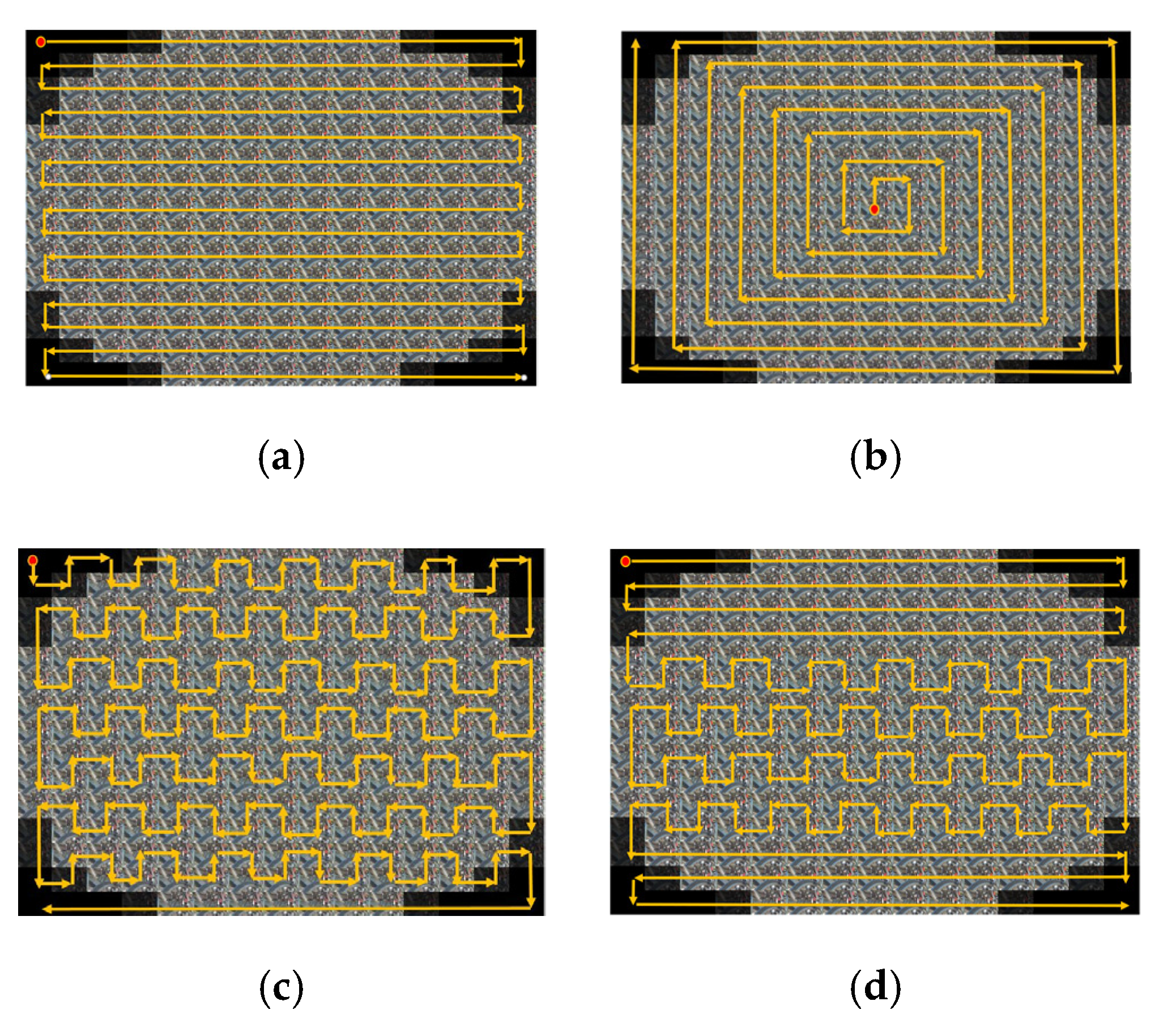

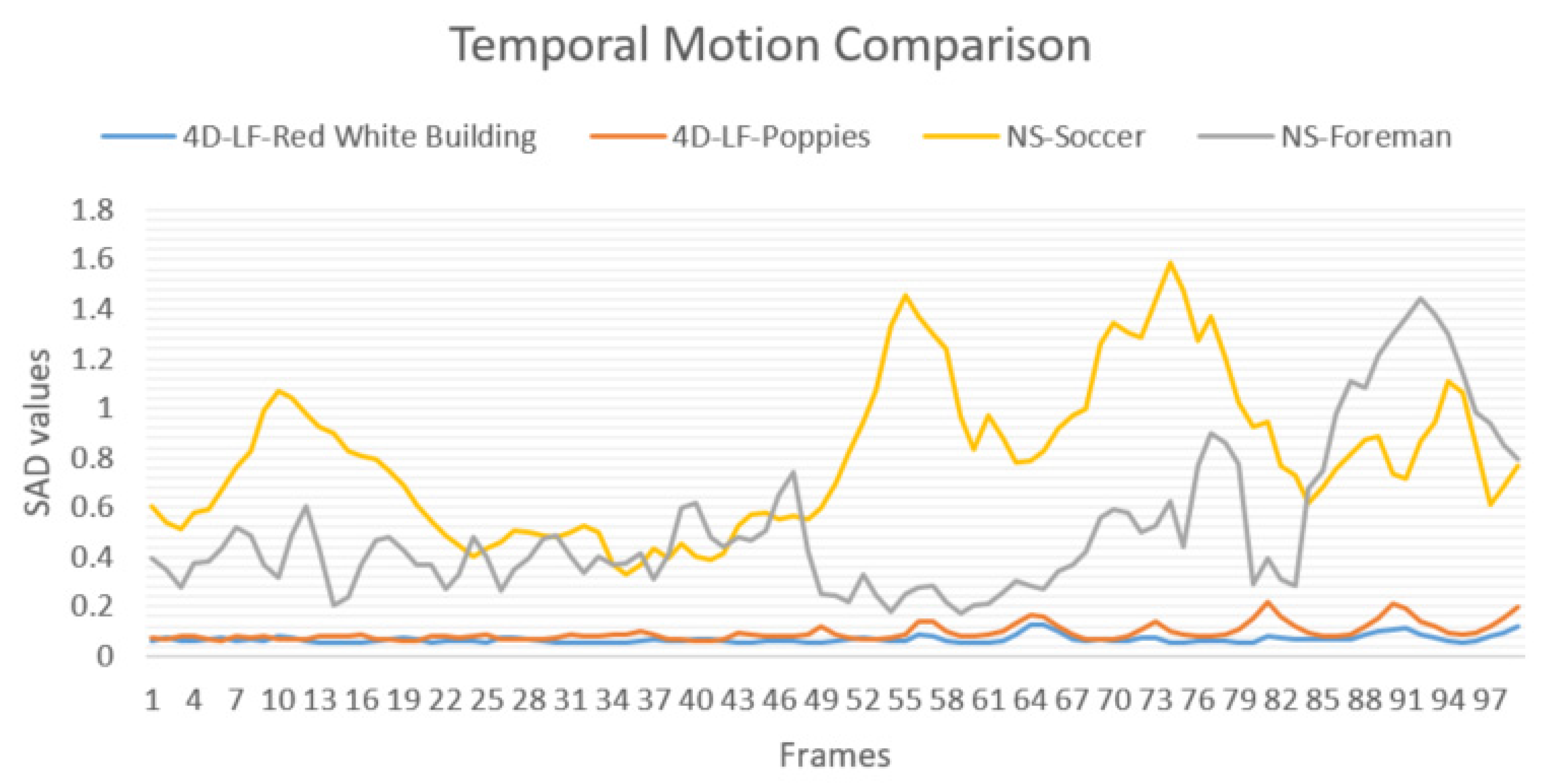
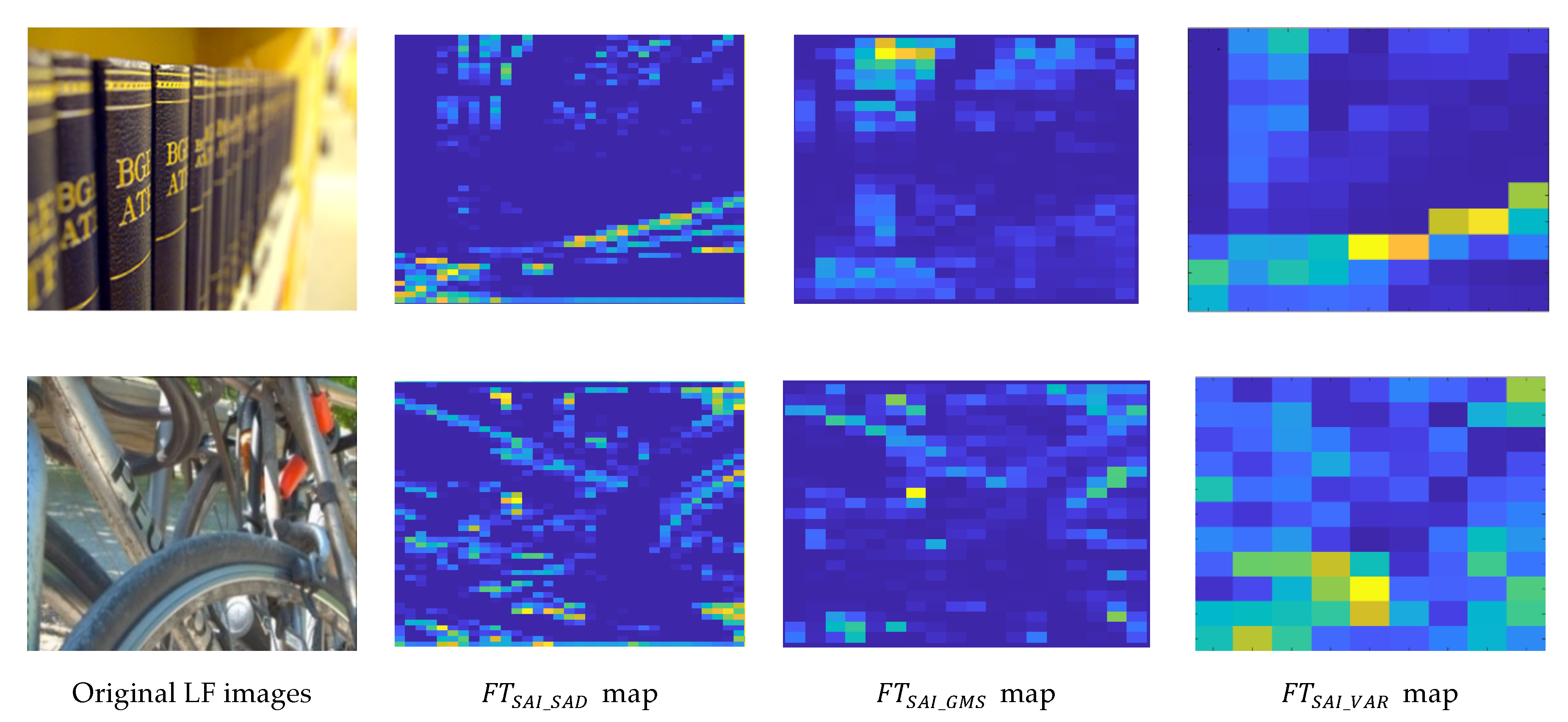



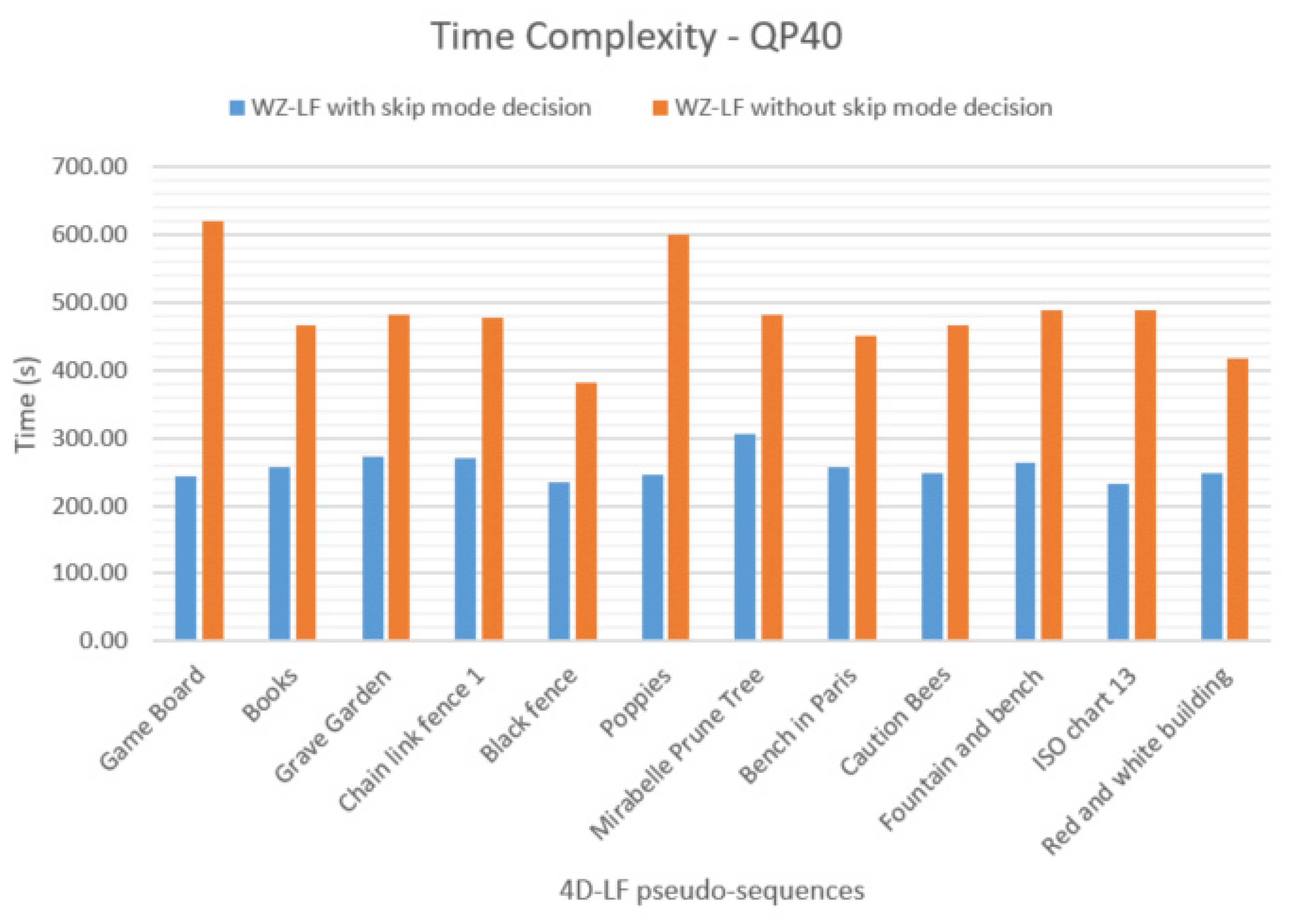
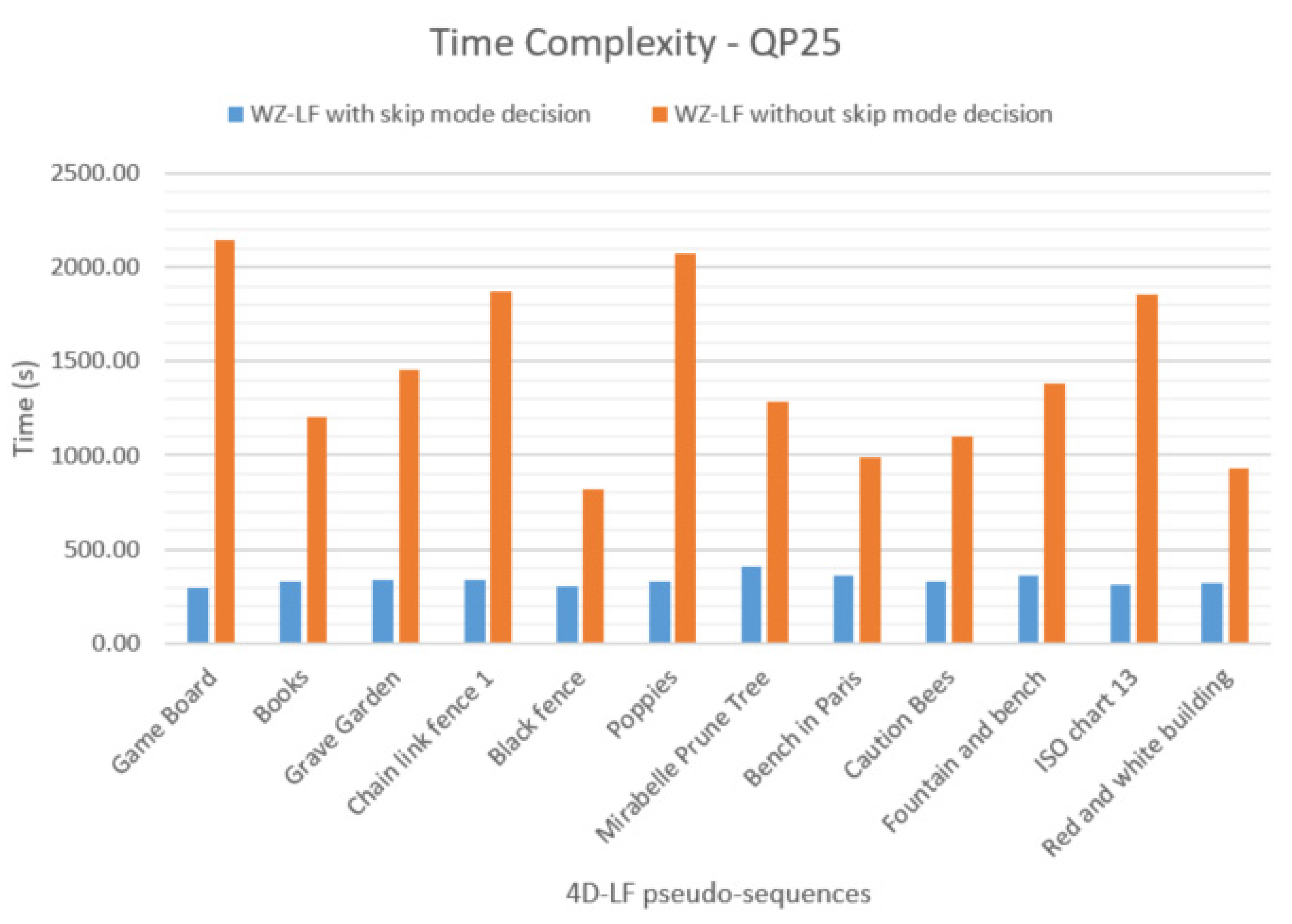
| LF Training Samples | Category | Content Types | Thumbnail Samples |
|---|---|---|---|
| Houses and lake | Landscapes | WDOF | 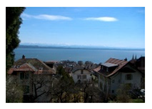 |
| Backlight 2 | Light | ||
| Rolex learning center | Buildings | WDOF-L |  |
| Reeds | Landscapes | ||
| Backlight 1 | Light | ||
| ISO chart 15 | ISO and color charts | BC | 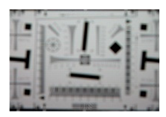 |
| Perforated metal 2 | Grids | ||
| Slab and lake | Landscapes | NDOF |  |
| Bush | Nature | ||
| Wall decoration | Urban | ||
| Sewer drain | Urban | NDOF-1 |  |
| Sophie and Vincent 2 | People | ||
| Ankylosaurus and Diplodocus 2 | Studio | ||
| Bikes | Urban | NDOF-2 |  |
| Danger de mort | Grids | ||
| Stone pillars outside | Urban |
| LF Sequences | Content Types | WZ-LF vs. DVC-H.265/HEVC (Anchor) [53] | WZ-LF vs. H.265/HEVC Intra (Anchor) [42] | WZ-LF (Anchor) vs. H.265/HEVC Inter [42] | DVC-H.265/HEVC [53] (Anchor) vs. H.265/HEVC Inter [42] | ||||
|---|---|---|---|---|---|---|---|---|---|
| - | BD Rate | BD-PSNR | BD Rate | BD-PSNR | BD Rate | BD-PSNR | BD Rate | BD-PSNR | |
| Red and white building | WDOF | −24.40 | 1.89 | −54.75 | 5.27 | −87.06 | 11.78 | −90.24 | 13.31 |
| Black fence | WDOF-L | −21.41 | 2.04 | −53.73 | 6.60 | −81.84 | 11.70 | −85.73 | 13.15 |
| ISO chart 13 | BC | −33.99 | 2.67 | −50.95 | 4.60 | −84.59 | 9.72 | −89.74 | 11.45 |
| Content Type Average | −26.60 | 2.20 | −53.14 | 5.49 | −84.49 | 11.06 | −88.57 | 12.63 | |
| Grave Garden | NDOF | −17.59 | 1.51 | −53.18 | 6.23 | −82.75 | 10.38 | −85.82 | 11.48 |
| Chain link fence 1 | −22.06 | 1.71 | −50.44 | 5.01 | −63.54 | 6.35 | −71.59 | 8.10 | |
| Game Board | −48.29 | 3.58 | −53.98 | 3.82 | −82.60 | 8.19 | −91.09 | 10.73 | |
| Content Type Average | −29.31 | 2.26 | −52.53 | 5.02 | −76.29 | 8.30 | −82.83 | 10.10 | |
| Bench in Paris | NDOF-1 | −15.88 | 1.48 | −54.69 | 6.95 | −82.85 | 10.91 | −85.59 | 11.95 |
| Caution Bees | −24.53 | 1.67 | −53.15 | 4.50 | −84.37 | 9.03 | −88.24 | 10.57 | |
| Fountain and bench | −20.29 | 1.47 | −51.81 | 4.76 | −79.10 | 8.52 | −83.37 | 9.96 | |
| Content Type Average | −20.23 | 1.54 | −53.22 | 5.40 | −82.10 | 9.48 | −85.73 | 10.82 | |
| Poppies | NDOF-2 | −32.92 | 2.45 | −54.23 | 4.63 | −80.49 | 8.31 | −86.95 | 10.44 |
| Mirabelle Prune Tree | −13.52 | 1.18 | −53.40 | 6.42 | −75.70 | 8.71 | −79.05 | 9.60 | |
| Books | −25.03 | 1.79 | −51.91 | 4.63 | −80.68 | 8.48 | −85.53 | 9.91 | |
| Content Type Average | −23.82 | 1.80 | −53.18 | 5.22 | −78.95 | 8.50 | −83.84 | 9.98 | |
| Total Average | −24.99 | 1.95 | −53.01 | 5.28 | −80.46 | 9.34 | −85.25 | 10.89 | |
| LF Sequences | Content Types | H.265/HEVC Inter vs H.265/HEVC Inter No Motion (Anchor) [42] | |
|---|---|---|---|
| - | BD-Rate | BD-PSNR | |
| Red and white building | WDOF | −0.03 | 0 |
| Black fence | WDOF-L | −0.13 | 0.01 |
| ISO chart 13 | BC | −6.33 | 0.32 |
| Content Type Average | −2.16 | 0.11 | |
| Grave Garden | NDOF | −1.97 | 0.10 |
| Chain link fence 1 | −18.51 | 1.16 | |
| Game Board | −0.87 | 0.04 | |
| Content Type Average | −7.11 | 0.43 | |
| Bench in Paris | NDOF-1 | −0.72 | 0.04 |
| Caution Bees | −0.98 | 0.04 | |
| Fountain and bench | −5.42 | 0.28 | |
| Content Type Average | −2.37 | 0.12 | |
| Poppies | NDOF-2 | −0.41 | 0.02 |
| Mirabelle Prune Tree | −1.55 | 0.08 | |
| Books | −1.49 | 0.07 | |
| Content Type Average | −1.15 | 0.07 | |
| Total Average | −3.20 | 0.18 | |
| Sequences | Content Type | BD Rate (Raster Scan as Anchor) | ||
|---|---|---|---|---|
| Spiral | Hybrid | U-Shape | ||
| Red and white building | WDOF | −9.50 | −2.81 | −1.62 |
| Black fence | WDOF-L | −11.30 | −3.59 | −1.47 |
| Chain link fence 1 | NDOF | −11.20 | 13.34 | 24.83 |
| Fountain and bench | NDOF-1 | −9.14 | 3.11 | 8.53 |
| Poppies | NDOF-2 | −9.58 | −3.03 | −1.16 |
| ISO chart 13 | BC | −13.81 | −2.97 | 1.07 |
| Average | −10.75 | 0.67 | 5.03 | |
| LF Sequences | Content Types | Skip Mode (Non-Skip Mode as Anchor) | |
|---|---|---|---|
| BD-Rate | BD-PSNR | ||
| Red and white building | WDOF | −24.40 | 1.89 |
| Black fence | WDOF-L | −21.41 | 2.04 |
| ISO chart 13 | BC | −33.99 | 2.67 |
| Content Type Average | −26.60 | 2.20 | |
| Grave Garden | NDOF | −17.59 | 1.51 |
| Chain link fence 1 | −22.06 | 1.71 | |
| Game Board | −48.29 | 3.58 | |
| Content Type Average | −29.31 | 2.27 | |
| Bench in Paris | NDOF−1 | −15.88 | 1.48 |
| Caution Bees | −24.53 | 1.67 | |
| Fountain and bench | −20.29 | 1.47 | |
| Content Type Average | −20.23 | 1.54 | |
| Poppies | NDOF−2 | −32.92 | 2.45 |
| Mirabelle Prune Tree | −13.52 | 1.18 | |
| Books | −25.03 | 1.79 | |
| Content Type Average | −23.82 | 1.81 | |
| Total Average | −24.99 | 1.95 | |
Publisher’s Note: MDPI stays neutral with regard to jurisdictional claims in published maps and institutional affiliations. |
© 2020 by the authors. Licensee MDPI, Basel, Switzerland. This article is an open access article distributed under the terms and conditions of the Creative Commons Attribution (CC BY) license (http://creativecommons.org/licenses/by/4.0/).
Share and Cite
PhiCong, H.; Perry, S.; HoangVan, X. Adaptive Content Frame Skipping for Wyner–Ziv-Based Light Field Image Compression. Electronics 2020, 9, 1798. https://doi.org/10.3390/electronics9111798
PhiCong H, Perry S, HoangVan X. Adaptive Content Frame Skipping for Wyner–Ziv-Based Light Field Image Compression. Electronics. 2020; 9(11):1798. https://doi.org/10.3390/electronics9111798
Chicago/Turabian StylePhiCong, Huy, Stuart Perry, and Xiem HoangVan. 2020. "Adaptive Content Frame Skipping for Wyner–Ziv-Based Light Field Image Compression" Electronics 9, no. 11: 1798. https://doi.org/10.3390/electronics9111798
APA StylePhiCong, H., Perry, S., & HoangVan, X. (2020). Adaptive Content Frame Skipping for Wyner–Ziv-Based Light Field Image Compression. Electronics, 9(11), 1798. https://doi.org/10.3390/electronics9111798




